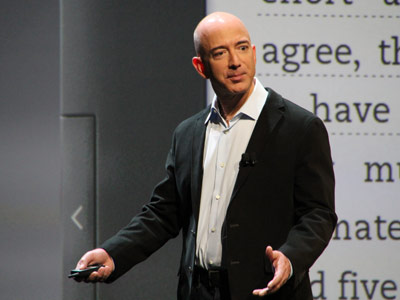Amazon is doing its real job: Squeezing retail chains
 One of the dramas in tech right now is the story around Amazon’s Kindle Fire tablet and its potential to mess up Apple’s iPad business. I don’t think the Kindle Fire (an okay-but-not-great media tablet) is a real, long-term threat to the iPad (the personal computer of the future, and potentially many more things). But that will take a while to sort out.
One of the dramas in tech right now is the story around Amazon’s Kindle Fire tablet and its potential to mess up Apple’s iPad business. I don’t think the Kindle Fire (an okay-but-not-great media tablet) is a real, long-term threat to the iPad (the personal computer of the future, and potentially many more things). But that will take a while to sort out.
The real story right now is that Amazon — both through its Kindle business and its broader e-commerce business — is driving retail chains crazy. This is by design, of course: Recall that e-commerce is still less than 5% of U.S. retail sales. So driving brick-and-mortar competitors into the ground and directing more spending toward Amazon is absolutely what Amazon should be putting most of its effort into.
A brief rundown of recent cries for help from the retail chain world:
- This morning, Barnes & Noble — whose biggest competitor is Amazon — “lowered its guidance for every one of its 2011 fiscal year metrics, including revenue, EBITDA, and online and offline sales,” Peter Kafka writes for All Things D. The Nook tablet is apparently popular, but the other Nooks aren’t, and digital content sales are up. Meanwhile, B&N is considering spinning off the Nook business. It only expects retail same-store-sales to grow 1% this year. And it expects a full-year loss. (More coverage at All Things D and Techmeme.)
- Also this morning, Target reported disappointing December sales. “December sales were below our expectations as growth in Grocery and Beauty offset softness in Electronics and Music, Movies & Books,” the company said in a release. Electronics, music, movies, and books — Amazon’s (and Apple’s) sweet spots, now Target’s weak spots.
- Last month, Best Buy reported lousy sales growth and predicted declining margins, which sent its stock down. Its comparable store sales grew 0.3% during the quarter. On the company’s earnings call, CEO Brian Dunn said of the holiday shopping market: “as we’ve all observed so far, retail has been very promotional and consumers have been value-conscious.” I can’t imagine the lower pricing and free shipping at Amazon aren’t driving sales away from Best Buy — and I can’t see that trend reversing itself. (More about Best Buy’s problems at Forbes.)
Meanwhile, Wall Street expects Amazon to report 40% year-over-year sales growth for last quarter, and a profit.
I’d love to see some contrarian evidence — signs that offline chain spending is picking up in categories where Amazon is a serious competitor. Or that any of these companies stand a chance to survive as digital-only companies. (Hey, at least Walmart just bought an iPhone app agency.)
But from my own habits, I can’t imagine why that would happen. Thanks to Amazon’s pricing, fast Prime shipping, and the dreadful condition of my local CVS, I have shifted almost all of my drugstore shopping to Amazon. Not to mention everything I’ve been buying from Amazon for years — kitchen supplies, electronics, movies, books, music, etc.
So, sure, the Kindle Fire line may become the Packard Bell PC of the 2010s, or whatever. But that’s maybe a few hundred dollars per person, per year. The real opportunity for Amazon is still to convert thousands or tens of thousands of dollars of offline spending per household, per year, into Amazon spending. And based on these signals from retail chains, that’s what seems to be happening.
Also: 10 things Apple must do in response to the Kindle Fire

Check out my new site: The New Consumer, a publication about how and why people spend their time and money.

